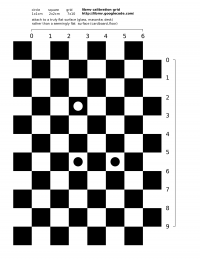Dev:Source/Motion tracking/Shots catalog
< Dev:Source | Motion tracking
2015年12月28日 (月) 04:08時点におけるwiki>Brechtによる版 (moved Dev:2.6/Source/Motion tracking/Shots catalog to Dev:Source/Motion tracking/Shots catalog)
目次
Clips catalog
See http://download.blender.org/ftp/incoming/libmv.
If you have some stuff to upload usable with libmv just put it there! Thanks!
General requirements
Textures
The scenes should have good texture so that tracking is easy.
We can add challenging scenes later.
Scene
- Boxes with texture are good.
- Complicated objects like bushes or trees are bad.
- The scene must be static (no cars, people, birds, godzilla, etc).
Camera
Sensor Implications
- CMOS sensors are affected by Rolling shutter!! CCD based sensors, are not.
- CMOS rolling shutter artifacts can break 3D reconstruction from 2D tracking. The LibMv team is well aware of this phenomenon and will implement a correction scheme soon.
- For this reason, possibly please use a camera with a CCD based sensor.
Calibration
Here's the procedure to calibrate the camera.
- Prepare the calibration grid
- Download this libmv calibration grid you see on the right.
- Affix it to a really flat object: something that has a bit of bend is unacceptable and will give poor results.
- Shoot it
- The checkerboard and camera should be still.
- Take several views of the calibration target at different angles (or a video in HD).
- The perspective on the checkerboard should be very apparent (in addition to front-on views).
- Each shot of the checkerboard should try to cover as much of the field of view of the camera as possible, while still showing the full checker board (important for distortion correction).
Note
This is important since the distortion tends to happen towards the edges of the view, so if the grid only occupies the middle 25% of the view it won't produce a good calibration. Even with the full autotracking that you get in the commercial packages, you can get superior results if you properly calibrate your camera; especially for difficult shots where there is ambiguity, etc.
|
- Calibrate the lens
Run one of the calibration tools, to find the lens intrinsic parameters:
- focal length x
- focal length y
- principal point x (center of projection)
- principal point y
- skew
- radial distortion coefficients (typically ~1-5 numbers) which describe:
- barrel
- pincushion
- tangential distortion
Types of required camera movement
| Type of movement | Description |
|---|---|
| Moving and rotating camera | Camera is not always pointing at one part of the scene. |
| Panning shots | Camera on a tripod, rotating around a fixed point (if possible the camera's "Nodal point", but you need a special tripod for that) |
| Sideways tracking shots | Walking sideways keeping the camera pointed forward (e.g. not circling). Hand-held wobbling is ok |
| Pull-in tracking shots | Walking towards the scene. Hand-held wobbling is ok |
| General motion with planar scene | Example: camera keeps a big billboard in view and only the billboard |
| Target tracking | Circle strafing around an object: camera points on one part of the scene (intersecting principal ray) |
